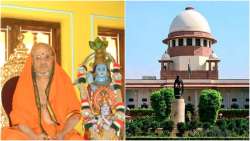Why Kesavananda Bharati vs State of Kerala case is considered landmark in India's independent history
Kesavananda Bharati challenged the Constitution (29th Amendment) Act, 1972, questioning the Kerala government’s attempts, under two-state land reform acts, to impose restrictions on the management of its (mutt) property. A 13-judge bench was formed to preside over the case, heard over 68 days. In which, 11 different judgments were delivered in what is said to be a 7:6 majority the ‘basic structure’ of the Constitution is inviolable, and could not be amended by Parliament.

Kesavananda Bharati Sripadagalvaru, the Kerala seer from Edneer Mutt whose property rights case in the Supreme Court in 1973 helped define basic structure under the Constitution, passed away at the age of 79. It was in the landmark Kesavananda Bharati vs State of Kerala after which it was ruled that the “basic structure” of the Constitution can not be amended. The Supreme Court in a 7:6 judgment had ruled that Parliament has no powers to alter the basic structure of the constitution. The arguments in the case of Kesavananda Bharati v State of Kerala went for 68 days.
What was the Kesavananda Bharati Case?
Kesavananda Bharati challenged the Constitution (29th Amendment) Act, 1972, questioning the Kerala government’s attempts, under two-state land reform acts, to impose restrictions on the management of its (mutt) property. Bharati also challenged three Constitutional amendments – the 24th, 25th and 26th amendments – introduced by the Indira Gandhi government. The principal question that was raised in the case was about the power of Parliament to amend the Constitution in totality especially with respect to fundamental rights. To simply put, the basic question that the Supreme Court had to decide was whether Parliament could alter, amend, abrogate any part of the Constitution even to the extent of taking away all fundamental rights?
Senior lawyer Nani Palkhivala, Fali Nariman, and Soli Sorabjee fought the case for Kesavananda Bharati. A 13-judge bench was formed to preside over the case, heard over 68 days. In which, 11 different judgments were delivered in what is said to be a 7:6 majority. The Supreme Court then ruled that the ‘basic structure’ of the Constitution was inviolable, and could not be amended by Parliament. The 'basic structure' doctrine has since been regarded as a tenet of Indian constitutional law.
Background of the Kesavananda Bharati case:
Such challenge --- Kesavananda Bharati case --- was inevitable, given government reactions to the court’s judgement in the Golak Nath case (1967). In Golak Nath case, an 11-judge Bench held that Parliament could not amend Fundamental Rights, including the Right to Property under the Constitution. This didn't sit well with Indira Gandhi’s government, after which Parliament passed major amendments, allowing amendment of Fundamental Rights and putting some property issues beyond judicial review.
In the early 1970s, the then PM Indira Gandhi- led government had enacted major amendments to the Constitution (the 24th, 25th, 26th and 29th) to get over the judgments of the Supreme Court in RC Cooper (1970), Madhavrao Scindia (1970) and above mentioned Golak Nath case.
In RC Cooper case, the court had struck down Indira Gandhi’s bank nationalisation policy, and in Madhavrao Scindia it had annulled the abolition of privy purses of former rulers.
All the 4 amendments -- 24th (fundamental rights, 1971), 25th (property rights, 1972), 26th (privy purses, 1971), 29th (land reform acts, 1972), as well as the Golak Nath judgment, came under challenge in the Kesavananda Bharati case.
Judgement: 'Basic Structure' of the Constitution:
The Constitutional Bench-led by Chief Justice SM Sikri -- ruled by a 7-6 verdict held that Parliament can amend every Article in the Constitution but should be restrained from altering the ‘basic structure’ of the Constitution.
The court held that under Article 368, which provides Parliament amending powers, something must remain of the original Constitution that the new amendment would change.
The court did not define the ‘basic structure’, and only listed a few principles — federalism, secularism, democracy — as being its part. Since then, the court has been adding new features to this concept.
The fallout:
Indira Gandhi government struck back against the Kesavananda Bharati verdict. Chief Justice of India S M Sikri retired the day after the verdict. Justice A N Ray, who was among the six dissenting judges succeeded him and became the 14th CJI superseding Justices Shelat, Grover and Hegde, who were on the side of the majority in the case. The case was again re-opened as Attorney General Niren De moved the Supreme Court, however, no review petition was filed. A 13-judge Bench was constituted to review the verdict by CJI Ray, as Master of the Roster. However, on November 12, 1975, the Bench was dissolved after CJI Ray yielded to immense peer pressure.
‘Basic structure’ since Kesavananda Bharati case:
The ‘basic structure’ doctrine has since been interpreted to include the supremacy of the Constitution, the rule of law, Independence of the judiciary, doctrine of separation of powers, federalism, secularism, sovereign democratic republic, the parliamentary system of government, the principle of free and fair elections, welfare state, etc.
Outcomes and implications of the judgment:
The 39th Amendment prohibited any challenge to the election of the President, Vice-President, Speaker and Prime Minister, irrespective of the electoral malpractice. This was a clear attempt to nullify the adverse Allahabad High Court ruling against Indira Gandhi.
The 41st Amendment prohibited any case, civil or criminal, being filed against the President, Vice-President, Prime Minister or the Governors, not only during their term of office but forever. Thus, if a person was a governor for just one day, he acquired immunity from any legal proceedings for life.